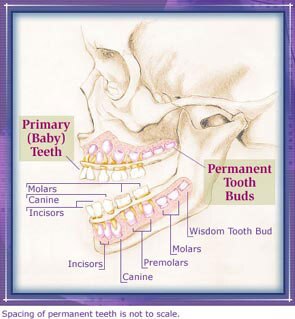Because there are more permanent teeth than primary teeth, the permanent premolars come in behind the primary molars. Permanent molars emerge into an open space. The jaw lengthens as a child grows to create space for these permanent molars.
It takes about six years, between the ages of six and 12, for children to lose their primary (deciduous) teeth and gain their permanent teeth. This is called the period of "mixed dentition," because for much of the time, children will have both primary and permanent teeth. Teeth form under the gum before they erupt (emerge through the gum). The crown, or visible part of the tooth, forms before the roots do. Before the roots form, the developing tooth is called a "tooth bud."
Eventually, the 20 primary teeth are replaced by 32 permanent teeth. The primary molars are replaced by permanent premolars (also called bicuspids) and the permanent molars come in behind the primary teeth. Most often, the first teeth to emerge are the lower two front teeth (incisors) and the upper and lower first molars, the molars closest to the front of the mouth. They are followed by the upper two front teeth. The order that teeth emerge can vary. Parents should be more concerned about symmetry (the same teeth coming in at the same time on both sides) than the time teeth emerge.
©2001-2003 InteliHealth Inc. All rights reserved.


Was this article helpful?
If you’d like a response, Contact Us.